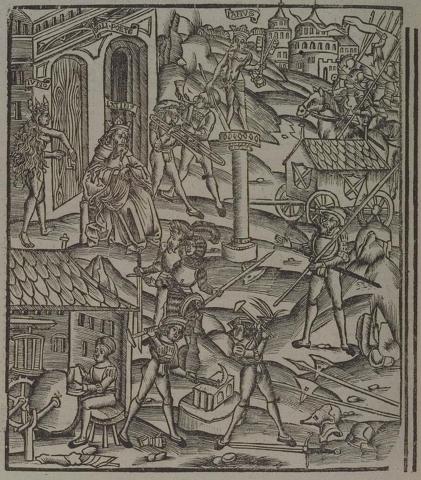Annotations
Latinus sits on his throne in front of the gates of war, near the statue of Janus, and with great displeasure he hears the men who have come to his city asking for war (585-90). It is interesting that Turnus is not pictured, since he is instrumental in gathering the men who are rallying in support of the war (577-9). Behind Latinus to the left, Juno opens the gates of war, which are depicted as wooden doors in a giant double arch (601-22). Behind him to the right, men sound the war trumpets (628). In the top right corner, mounted cavalry bear a standard with a symbol of a bird. In the foreground the preparations for war have begun: men hammer out weapons on an anvil (629-36), while another sharpens blades on a grindstone (627). A sword, a pair of greaves and a pair of battle axes lie on the ground, all freshly made (629-36). (Katy Purington)
Woodcut illustration from the “Strasbourg Vergil,” edited by Sebastian Brant: Publii Virgilii Maronis Opera cum quinque vulgatis commentariis expolitissimisque figuris atque imaginibus nuper per Sebastianum Brant superadditis (Strasbourg: Johannis Grieninger, 1502), fol. 303v, executed by an anonymous engraver under the direction of Brant.


Sebastian Brant (1458-1521) was a humanist scholar of many competencies. Trained in classics and law at the University of Basel, Brant later lectured in jurisprudence there and practiced law in his native city of Strasbourg. While his satirical poem Das Narrenschiff won him considerable standing as a writer, his role in the transmission of Virgil to the Renaissance was at least as important. In 1502 he and Strasbourg printer Johannes Grüninger produced a major edition of Virgil’s works, along with Donatus’ Life and the commentaries of Servius, Landino, and Calderini, with more than two hundred woodcut illustrations. (Annabel Patterson)